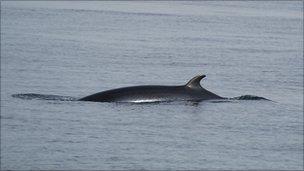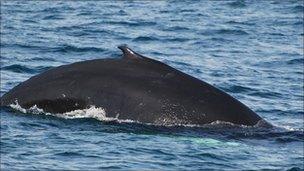Why is Humber becoming a hotspot for whale strandings?
- Published

Minke whales are common in the North Sea
Experts say the whale found stranded in the Humber last week was of the rare sei species. This is the latest of a number to have died in the area recently. So why is the Humber Estuary the site of so many dead whales?
The North Sea is awash with minke whales. According to the Sea Watch Foundation, about 10,000 of the mammals are estimated to be in the waters, feeding off fish such as mackerel and herring which can be found in abundance near the north-east coast.
The charity, which is working to improve the conservation of whales and dolphins in British waters, has recorded between three and 12 sightings a day this summer and has photographically identified nine minke whales off the Yorkshire coast.
Robin Fetch, from the Sea Watch Foundation, said: "It's not unusual to find whales here. We've always had whales following the herring down the coast, usually during late summer when they come to feed."
However, the two whales stranded this month off the North Lincolnshire coast - a fin and the rare sei species - are usually found in the deeper waters of the Atlantic ocean.
More sightings
The Yorkshire Wildlife Trust (YWT) has recorded a rise in recordings of larger-sized cetaceans in 2011.
Kirsten Smith, of YWT, said: "We're seeing more and more larger whale strandings round the UK, particularly on the east coast.
"In the last year we've seen sperm whales around the Northumberland coast stranded, we've seen obviously the fin whale last week stranded in the Humber and now this sei whale.

A humpback whale has been spotted in the North Sea
"We're also seeing more bigger species being noted off-shore, for example at the minute there's a group of about 10 minke whales of the Yorkshire coast and we're also seeing more humpback whales in the North Sea as well."
One theory floated by experts is a change in the ocean current streams, which is causing confusion for some deep sea cetaceans.
Mr Fetch said: "I think as they come in to the shallower waters they're getting confused by the amount of boat traffic and the tides.
"There's roughly seven metres of tide at the mouth of the Humber and these deep ocean whales aren't really used to that.
"All the waters off shore round the Spurn are much shallower than anywhere else around the coast and the whales are following fish down the coast."
Public awareness
Whale experts admit there is no definitive answer about the surge of strandings and sightings. Others believe that conservation work is leading to more public awareness.
Ms Smith said: "We're really keen to develop a picture of what's going on out there. The Wildlife Trust works really heavily in getting information about the marine environment and looking at how we protect our wildlife out there.
"We're really keen to get a feel for the sightings that are going on that people are seeing, the amount of strandings that are going on and to get people to contact us and to show support for the marine environment."
- Published29 September 2011
- Published23 September 2011
- Published8 September 2011
- Published21 July 2011